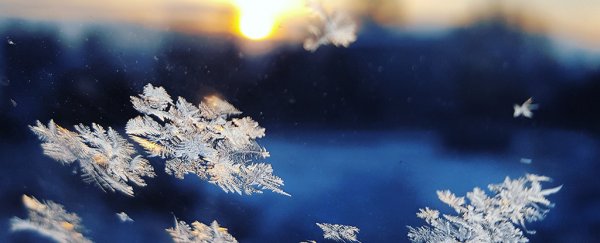Freezing temperatures and industrial activity may sound like a recipe for disaster, but sometimes, beautiful things come from strange places.
In the frigid cold of winter, two industrial power plants on the outskirts of a small town in Nebraska have caused a rare and unusual weather event.
For more than a day, residents living downwind of the town of Norfolk were treated to a dusting of effectively human-made snow, thanks to the freezing billows of a nearby power facility.
The National Weather Service (NWS) noticed it first on their radar: a tiny pocket of snow, drifting downwind from Norfolk.
The teacup storm lasted for a whole day, and on Tuesday, the weather was back at it again, swirling down south towards Omaha, causing up to five centimetres (two inches) of snow in some places.
The NWS has since confirmed that the unusual band of snow was caused by two power facilities in Norfolk - a steel manufacturing plant and an ethanol processing facility.
It's been confirmed that this snow band is originating from 2 plants in Norfolk. The steam produced there is essentially acting to add moisture and warmth to the clouds creating the snow. Had reports of large flake and up to 1in. If you live in that area how much have you seen? pic.twitter.com/mSiVcj6uH2
— NWS Omaha (@NWSOmaha) December 3, 2018
Even though these snowflakes come from an unusual source, they are indistinguishable from those made by nature alone. An expert told Vice's Motherboard that they are "pretty basic" snowflakes in reality.
But that doesn't mean they aren't special. These unexpected dustings are an extremely rare weather phenomenon, colloquially called industrial snow.
Most power plants, like the ones in Norfolk, puff out immense clouds of steam and exhaust, most of which evaporates into the air. But if it's bitterly cold and all the right weather conditions align, something curious and beautiful can happen.
Sometimes, when the steam doesn't rise and evaporate, it gets stuck in the clouds above, plumping them up like pillows. Given the right conditions, these extra chubby clouds can then produce or enhance local weather conditions.
When the atmosphere is at the perfect temperature for snow, the cloud's particles turn into ice crystals, causing snowflakes to drift down out of the heavens and onto the ground below.
The same sort of thing happens when you pour a pot of boiling hot water out into the frigid cold: it instantly turns to snow.
December in Nebraska: ponds at ends of fields after 1-2” of rain on partially frozen soil topped with a few inches of snow aided by the steam from nearby industrial plant. 🤷♂️ pic.twitter.com/TeZA4WeiH5
— Tyler Williams (@tylerw_ag) December 4, 2018
"Big chimneys release water vapour and other gases and particulates, which can lead to the formation of fog," explains a statement from NASA on industrial snow fall in the Netherlands last year.
"It also turns out that these emissions can create snow when the weather gets cold enough."
The NWS in Omaha says the physics is similar to lake-effect snow. This phenomenon occurs when cold wind drifts over warm lake water, causing some of the water below to evaporate and warm the air above.
This humid plume of steam then rises until it cools off and dumps all of that moisture back onto the ground as rain or snow, depending on how cold it is.
Check this out. Here is a loop of the snow induced from the plants in Norfolk. This loop starts yesterday at 7am and goes through today at 7am. Watch as the snow finally blows off toward the east around 4am this morning. #newx #iawx pic.twitter.com/u1bxieigIJ
— NWS Omaha (@NWSOmaha) December 4, 2018
It's considered a rare and obscure phenomenon, but it actually happens more than you might think - there have been several recent examples.
Earlier this year, Northern Kentucky was treated to a dusting of snow courtesy of a nearby power plant. In 2013, a nuclear power plant caused a similar storm in Pennsylvania.
And in 2014, Chicago was gifted with a snowfall that experts thought was caused by soot that was spewing from nearby smokestacks.
Who knew that emissions could bring us such joy?
